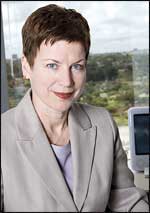The excitement over 64-slice CT is justified, and it has riveted more than just the entrepreneurs in our business.

|
You also will die, of course, if you read this. Death, like taxes, is a given. And if my home mailbox is any indication, we are in for a new round of retail radiology and its ride-along threats.
I received a real doozy from a Los Angeles imaging center in the 90210 ZIP code, and I have been shaking ever since. It seems that I have all nine indications that were listed for a 64-slice CT screening examination, including age in excess of 45 years, except for diabetes and erectile dysfunction.
“Every 20 seconds, someone dies from heart disease, cancer, stroke, or lung disease,” the flyer advises. “In only 20 seconds, you can be screened for ALL four of the major killers in the United States.”
We have been here before, and in spite of the best efforts of some very clever and enterprising people, few screening centers survived the purge of the turn of the 21st century. Chalk it up to millennium fever or the crash of the stock market, but entrepreneurs were not successful at filling their 16-slice scanners with sufficient throughput to cost justify the enterprise. At 20 seconds per whole-body scan on a 64-slice CT, this endeavor will be even more challenging.
The excitement over 64-slice, nonetheless, is justified, and the technology has riveted more than the entrepreneurs. Radiologists are swooning over the images, and cardiologists are swarming CME conferences to get up to speed on cardiac CT angiography (CCTA). And at least one radiology benefits management company is already making plans to assess the efficacy of CCTA as a screening tool (See “Payor Watch” in this month’s issue). Although it is highly unusual for a payor or its representative—the benefits management company in this case—to conduct its own research into a new technology, this development is also a testament to the power of the 64-slice technology both to add cost to the system and to remove cost. My father, for instance, recently underwent a catheterization based on a false-positive stress test, one of the 15% or so annual false positives. That probably would not have happened if he underwent 64-slice CCTA instead of a stress test.
It is the position of the American College of Radiology that disease-specific CT screening appears promising; however, it also states that there is not sufficient evidence to recommend total body CT screening for patients with no history or family history suggesting disease, and it expresses concern over wasteful follow-up studies.
Meanwhile, ever since that flyer arrived, I have felt a pulling sensation in my neck every time I hold my head at a certain angle, and I probably will not sleep through the night until I have an ultrasound or the sensation subsides, whichever comes first. If there are any owners of 64-slice scanners planning a marketing blitz in the 90505 ZIP code, please, I beg of you, drop me off the mailing list. My heart cannot take it.
Cheryl Proval
Editorial Director





